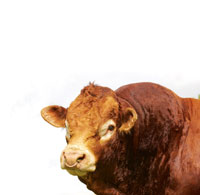Can you cheat the EBV system?

Some breeders believe estimated breeding values for beef animals can be manipulated by submitting enhanced data. Jonathan Long investigates
For many cattle breeders, estimated breeding values (EBVs) are an essential part of the selection process, allowing potential sires to be selected not just on looks, but also on predicted genetic ability.
However, there is also a belief, held by a minority, that EBVs can be manipulated by breeders to increase the appeal of their stock. But that isn’t the case, according to managers of the two EBV systems in place in the UK, Signet and Breedplan.
Signet manager Sam Boon says the number of checks in place is more than sufficient to spot anyone attempting to cheat the system. The biggest of which is the computer system, which has a number of pre-set parameters outside of which data is impossible to input. “If someone sent in a set of weights that was outside the accepted parameter, the system would reject the data. That triggers us to ask the breeder if the data is correct. In most cases, there is an obvious reason for the data being incorrect, and more often than not it is the weigh scales that are faulty, having been incorrectly calibrated.”
It can also be human error that is at fault – with most records still handwritten it is easy for mistakes to happen. “Beyond this, the system also flags up any data that, while within the accepted parameters, look out of place,” explains Mr Boon.
This is also the case with Breedplan, says manager Barbara Webster. “Every time we run the system it will produce outlier reports that highlight any animals whose data appears not to match the expected trend. This could be because they have a significant difference to their siblings or herd mates, or because they just don’t fit the pattern seen in a breed at the time.
“This can easily be the case when breeders are submitting calving ease data. Some sires are notorious for being tricky calvers. When someone submits forms that list calves of some of these more difficult calvers as having the top calving ease score, they are immediately flagged as outliers and questions are asked.”
Equally, someone submitting a low birth weight for a calf by a particular sire, compared to all other calves by the same sire, will find that calf is flagged up as an outlier and will be checked. “Again, data from its relatives will come into play.”
Calving ease is typically where some breeders feel the system can be cheated, but this isn’t the case, says Ms Webster. “When all progenies from a sire are recorded as easy calving, then the analysis finds no variation and the data will be drawn largely from other relatives. The across-breed analysis means genetics will eventually come to the fore and anyone submitting false data will be found out.”
The same is true of weights taken at 200 and 400 days, and under the Breedplan system most breed societies offer incentives to encourage muscle and fat scanning at 400 days. “This is undertaken by a Breedplan trained and accredited scanner and is done at the same time as 400-day weights are recorded. The scanner takes the weights as well, so providing a verified check weight to go into the system.” The same is true of 400-day weights under the Signet system.
All animals presented at a breed society sale are also weighed, providing another vital check weight to compare data. “This weighing allows growth rates to be examined, and any animal with a growth rate that looks out of balance with earlier weighings will be investigated.”
And, crucially, because of how both systems calculate the EBVs, comparing animals not only to their herd mates, but also to all their recorded relatives, the raw data is only a limited part of the eventual EBV produced, explains Mr Boon. “The raw data collected on-farm is balanced with data collected from all these other animals. This means many of the environmental effects, such as feeding and management, can be accounted for and their effects heavily discounted.”
When it comes to those animals whose data appears to be outside normal parameters, it is down to the relevant breed society to handle this, with harsh penalties for those found transgressing the rules. Penalties differ for each breed, but most reserve the right to inspect any stock with unusual data, suspend membership, or force breeders to notify all births within 48 hours.
To see reports from all the main May bulls sales and join the EBV debate visit www.fwi.co.uk/takingstock
